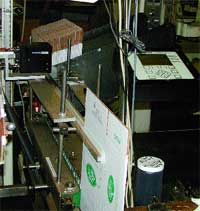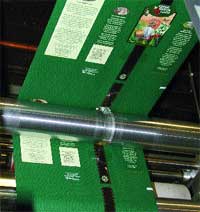January 29, 2014
It's hard to imagine now, but before the blossoming of the gourmet/specialty coffee culture in the '90s, coffee was regarded as an old-fashioned beverage for an aging crowd, with just two varieties from which to choose: "regular" or "decaf." Today, coffee is a personal expression, an occasion, an obsession. Options in size, flavor, preparation, condiments and toppings keep coffee houses percolating and coffee roasters thriving.
For Waterbury, VT-based Green Mountain Coffee Roasters, a supplier of specialty coffees for retail, institutional and foodservice venues, this revolution in coffee consumption has encouraged the development of a staggering range of coffee varieties and packaging. Whatever the mood, taste or preference of the customer, GMCR has a blend or flavor. To identify its more than 200 different coffee varieties on a range of film packaging, GMCR has wholly embraced coding technology from Markem Corp. Since the acquisition of its first SmartDate® 2i thermal-transfer coder in January, 1997, the company has added 13 more SmartDate coders, one 9880 Touch Dry® electronic motion coder and one 5000 Series case-coding system to 12 of its 16 packaging lines.
Coffee for every taste
Established in 1981 on the cusp of the coffee culture explosion, as a small caf? that roasted its coffee beans on the premises, GMCR today is one of the country's leading specialty coffee suppliers, with more than $100 million in sales in 2002. The majority of GMCR's revenue is derived from its wholesale operation, which serves supermarkets, convenience stores, offices and other locations where fine coffees are sold. The company also operates a thriving direct-mail operation and an e-commerce website.
Besides offering its customers a large and varied flavor lineup, GMCR also allows them to select from a number of grind styles, including whole bean, autodrip, espresso and others. Film packaging includes 10- and 12-oz side-gusseted, cathedral-top retail bags; 4- and 5-lb institutional bags; 1.75- and 2.2-oz institutional and retail fractional pouches; 6- and 14-oz pouches for dispensing into institutional urns; and overwraps, which consist of single- or double-overwrapped, single-pot filter packs. The company also recently launched the K-Cup®, a plastic cup with a filter and a foil lid that contains enough ground coffee for an 8-oz serving made with Keurig Premium Coffee Systems' single-cup brewing system.
To convey the premium quality of the products contained inside GMCR's myriad packaging formats, the company has carefully selected its packaging materials and artwork, with many formats decorated with evocative, watercolor-like graphics. "That's one of the things we pride ourselves on," says Jeff Sweetser, maintenance department manager for GMCR. "We have a variety of different packaging and one of the best-looking bags on the market–if not the best."
Most recently, GMCR redesigned its basic 10- and 12-oz retail bags, and its 4- and 5-lb institutional bags (see PD, June, 2002, p. 60) to include a proprietary pattern coating from Fres-Co Systems that results in a Corner Seal™ package formed on two new Fres-Co intermittent-motion Model GL 14 vertical f/f/s machines.
Coding streamlines packaging
While package sizes and bag graphics for GMCR's products vary widely, what could be a packaging material inventory nightmare, as well as a Herculean challenge in terms of packaging equipment changeover have largely been alleviated through the use of 14 thermal-transfer coders on 12 of its packaging lines that add identifying information to nearly all of the company's master pouchstocks. Since the first one was purchased in 1997, Markem's SmartDate coders have gradually replaced the hot-stamp units, as well as some other vendors' thermal-transfer coders, formerly used on GMCR's lines to add product descriptions and bar codes.
"The hot-stamp units were basically bullet-proof and were standard in the industry," says Sweetser. "They were very good units, but you had to order these aluminum plates for each code, and you had to change them every time you changed over to a new package."
The SmartDate coders allow GMCR to add everything from single-line and multiline copy formats in type sizes from 2 to 20 mm, to bitmaps and bar codes onto pouchstock in-line on f/f/s equipment, before the pouch is formed. Job setup, says Sweetser, is "very, very simple," and changeover, he adds, "is done at the touch of a button."
Fractional packages, formed from several master pouchstocks and run on f/f/s equipment from General Packaging and Universal Packaging (see PD, November, 1997, p. 76), receive variety name, for institutional packs, and name and bar code, for retail use. Ten- and 12-oz Corner Seal pouches receive product information and bar codes on their side panels, while preprinted labels on the front panel provide a more upscale appearance. Four- and 5-lb bags receive coding, as well as a 2-lb bag.
|
Coding of preprinted cases of institutional fractional packs is done using a hot-melt ink-jet coder. |
Printing is accomplished at speeds anywhere from 15 to 100 bags/min, depending on the bag size, with an average speed of 20/min.
Coder benefits mount
After purchasing its first six SmartDate coders, GMCR installed Markem's CimControl™ networked data-management system, which allows all of the coders to be controlled from a central PC. All code formats are created via Markem's Composer™ software at the main PC, and are downloaded as needed to the individual SmartDate units through the network. Each coder is capable of holding in memory up to approximately 100 single-line formats or 40 bitmaps or bar codes, Sweetser estimates.
In the near future, GMCR's marketing department will be connected to the network, with responsibility for designing the codes. For a trained operator, Sweetser says, creation of a multiline format with a bitmap, for example, takes just 10 to 15 minutes, while editing a saved code in the database is "a two- to three-minute job." Operating the coders is a fairly simple process, as well. "It takes a whole thirty minutes to teach a new operator what they need to know to use these machines," he says.
The SmartDate 2i offers a 300-dpi resolution and provides what is, in Sweetser's opinion, "excellent print quality, comparatively speaking, to other printers, time and time again."
He adds: "Percentage-wise, 99.9 percent of the time it's as close to perfect as it can be."
Maintenance, so far, Sweetser relates, has been confined to fixing ribbon cassettes that have been damaged when accidentally dropped by machine operators during cassette changeover. "We haven't seen anything else really," he adds.
In terms of efficiency, the SmartDate's ribbon-saving feature is "fantastic," Sweetser raves. "No matter what you print–a multiline code, a bar code, anything–there is barely any noticeable nonprinted area on the ribbon between the hits," he says. "On our previous machines, if you didn't have someone set up the coder right, you could actually be wasting twenty-five to fifty percent of the film ribbon.
"With the SmartDate, between startup and finish, you may end up wasting ten centimeters of ribbon at the very most. It's incredible."
Filter packs easily identified
In 1997, GMCR also added Markem's 9880 Touch Dry® intermittent electronic motion coder specifically to label its single-pot filter packs with a "decaf" designation. Using Touch Dry inks, which are nonhazardous, solventless hot-melt compounds approved by the U.S. Dept. of Agriculture for food contact, the Model 9880 prints directly onto the filter pouch material before forming. While the machine is rated at 140 cycles/min, Sweetser says the machine averages a 30/min output at GMCR.
Copy on the filter pouch is printed 4 mm high and 30 mm wide, but the size can be made larger or smaller, depending upon need.
|
Pouchstock for 10- and 12-oz retail packages receive bar codes on what will become the package's side panel. |
"We don't use the printer anywhere near its capability," says Sweetser. "We wanted to buy a unit that had growth, so that we can offer customers greater flexibility in the future, such as printing bar codes on the filter packs."
Easy to set up and operate, the coder uses brass printing dies to transfer the ink to the pouch material. Changing a job is as easy as sliding the letter dies into a small rack, Sweetser says, and can be accomplished within minutes. Maintenance includes periodically changing the ink rollers and cleaning the letter dies.
Case coder eliminates labels
Literally last in line is GMCR's Markem 5000 Series hot-melt ink-jet case coder, which was purchased in early 2000 to print product information on 24-count corrugated cases of 1.75- and 2.2-oz fractional packs bound for office coffee services.
"It saves us an incredible amount of money," says Sweetser, "because we don't have to purchase labels or a labeler. It just prints right on the side of the box, and as far as clarity goes, the print is extremely easy to read."
Corrugated case blanks, preprinted with the GMCR logo and other graphics, are fed through the magazine of the 5000. Also using Touch Dry inks, the 5000 prints the coffee name, product description, a bar code and a best-before date inside a designated area on the case flap.
While the 5000 is capable of controlling up to four printheads, GMCR is using only one at present.
As with its sister printers operating in the GMCR plant, the 5000 Series is also easy to set up and operate, relates Sweetser. The former involves purging the system of excess ink upon startup, and the latter, the selection of a preprogrammed label format and the push of a button. Operating on the CimControl network, the 5000 Series can be programmed through the plant's main PC. Maintenance is comprised of "general upkeep," Sweetser adds.
Reliability is key
As there's no break in the coffee business in sight for GMCR, the company's future considerations include replacing five coders on its five machines producing the Keurig K-Cup. Says Sweetser: "The coders that we are using now are just a maintenance nightmare.
"Our production is driven by getting product out. The coders are holding us up. We've got to find something that's more reliable. The Markem 5000 fits right in with our current system."
More information is available:
Coders, network software, design software: Markem Corp., 866/263-4644. Circle No. 240.
Adhesive lamination, v f/f/s: Fres-Co System USA, Inc., 215/721-4600. Circle No. 241.
F/f/s: General Packaging Equipment Co., 713/686-4331. Circle No. 242.
F/f/s: Universal Packaging, Inc., 800/324-2610. Circle No. 243.
About the Author(s)
You May Also Like




